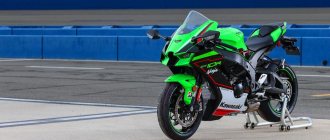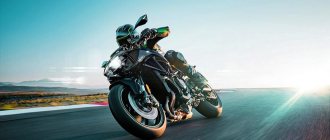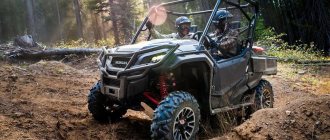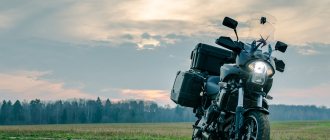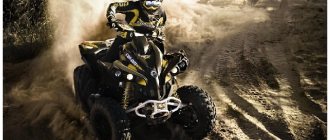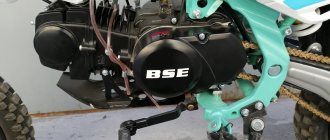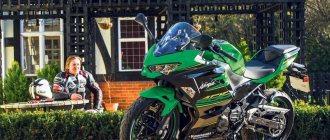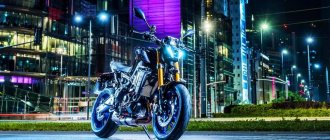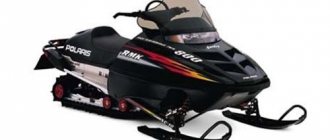Inspired by the success of the Versys 650 version, Kawasaki decides to release a liter, which should also become tourist enduro, But flagship of the line, incorporating all the advantages from the first development and adding additional ones.
The new motorcycle is called Kawasaki Versys 1000 and is presented to the public at the Milan Motor Show 2012 Despite its young age, the model managed to survive one restyling, when almost everything was changed, with the exception of the power plant.
Specifications
The power unit for the Versis is a four-cylinder and sixteen-valve in-line water-cooled engine.
When creating the engine of the new bike, the developers moved away from the solution used on the 650.
| Kawasaki Versys 1000 | tourist enduro (tour-enduro) |
| Year of issue | 2012-present |
| Frame | steel diagonal (2012-2014) aluminum tubular - Versys 1000 from 2015 |
| engine's type | 4-cylinder, 4-stroke, in-line |
| Working volume | 1043 cm³ |
| Bore/Stroke | 77.0 x 56.0 mm |
| Compression ratio | 10.3:1 |
| Cooling | liquid |
| Number of valves per cylinder | DOHC, 4 valves per cylinder |
| Fuel supply system | injector, 4x Keihin TTK38 |
| Ignition type | transistor |
| Maximum power | 118.0 hp 2012-2014 120.0 hp since 2015 |
| Maximum torque | 102.00 |
| Transmission | 6 manual transmission |
| type of drive | chain |
| Front tire size | 120/70ZR17M/C (58W) |
| Rear tire size | 180/55ZR17M/C (73W) |
| Wheelbase | 1520 mm |
| Acceleration to 100 km/h | 3.5 sec |
| Maximum speed | 226 km/h |
| Gas tank capacity | 21 l |
| Motorcycle weight (curb) | 239 kg 2012-2014 250 kg since 2015 |
The liter received a 4-cylinder liquid-cooled engine. The location of the pistons is, as before, in a row.
Transmission and clutch
The main drive is a classic chain.
As is customary among tourists, the bike received a 6-speed gearbox . But user opinions about it are very mediocre . Only she herself knows when it will work normally. Sometimes it clicks well, and sometimes it doesn’t click at all. Whether it turned on or not is a lottery .
- The main drive is a chain .
- The clutch is multi-plate with power transmission via a cable.
Brakes
Standard discs are used as brakes - 2 on the front wheel, 1 on the rear.
Front brakes.
Rear brakes.
The diameter of the rotors is respectively 310 mm/250 mm . Hydraulic support is provided by a 4-piston caliper at the front, 1-piston at the rear.
In 2012, the front caliper became radial . ABS for both wheels as standard.
I didn’t have much experience in owning various bikes, it all started with a Suzuki Burgman 150 scooter. After riding it for a year, I switched to a Yamaha X-Max 250. After riding scooters for several years, I decided to switch to motorcycles and the first was the brand new Kawasaki ER-6n. After riding it for 3 years, I bought a second Aprilia Tuono 1000 bike. There were two motorcycles in the garage for completely different purposes. But it's time for an upgrade.
It’s worth mentioning here that for several years I dreamed of going to the Tourist Trophy race on the Isle of Man and finally decided to do this trip, and for this I needed to change the bike. I wanted a tourist of average weight, but with an obstinate and sporty character, since I like to ride with the wind. After several months of exploring various new models on the market, the choice is made - the Kawasaki Versys 1000, which has its roots in the popular Z1000 model.
Having sold both of my bikes, all that was left to do before ordering a Versys 1000 was to feel it with my own hands and ride it. Since the dealer in Cyprus did not have this model in stock, and the only dealer here on the island, to put it mildly, is not entirely adequate, I decided to fly to Athens and get acquainted with this new product in person, and if I like everything, then buy it in Greece too. There were several reasons for this decision, but the main ones, of course, were the price (in Greece it cost 4,000 euros cheaper) and the fact that my trip to the Tourist Trophy still had to start in Greece.
We agreed with the dealer on a specific date in December 2015, and upon arrival, a bike ready for testing was waiting for me. Here is a video test of the drive, without any of my comments. I drove around the city for about an hour trying it on and looking closely at how it behaves in various situations. I liked everything, except for a few things that I can easily correct after purchase.
Immediately after the test, we placed an order and I received it in early January of this year.
8 months have passed since the purchase and after traveling 12,000 km I can leave my review about this bike. I will try to convey my feelings about the motorcycle as honestly and sincerely as possible, comparing it with my previous models. From additional options were ordered: - Original Kawasaki hand protection - Original Kawasaki saddlebags. — Slider protector for the engine
The dealer did not have the original GPS mount and 12V cigarette lighter in stock, but Kawasaki advised me to buy a SW-Motech mount since that is exactly what they sell under their brand. I attached a RAM Mount to it and it turned out to be very convenient; while driving, my eyes are not distracted from the road. It looks like this:
There are two holes in the plastic, for the cigarette lighter and for the gear indicator, both are available as an option. I didn’t take the indicator and installed the cigarette lighter myself, but I had to redo the electronics. diagram. I was not happy with the fact that power is supplied only when the ignition is on. Often it was necessary to charge the phone while standing still, but keeping the ignition on for so long is not the case. The ignition switch has a Hazard position - with it the ignition is turned off but power is supplied to the emergency lights. So, I printed out the email. diagram, found where to switch the power supply to the relay, and voila... power is supplied to the cigarette lighter both when the ignition is on and off, but only if the key is in the hazard position. All that needed to be done was to transfer the accessory relay coil power supply wires to 5 cm. Paste into email post The diagram will not work, it is too big, if anyone needs it, write, I will send it by mail. I still don't like the factory suspension setup. It was too soft, about 40% sagging. The ride was soft and comfortable, as if I was in a Mercedes, but it didn’t feel comfortable when cornering. There was no feeling of grip on the road. I adjusted the suspension to suit my weight and slightly to the sport mode, and set the sag of the front and rear suspension to the same 29%. There was no need to touch the dampers. Now I go through mountain serpentines and turns much more confidently, the bike lays down easier, and on the very first ride I hit the left step. It’s very easy to adjust the suspension, and if you want to play around or go long distance, the changes will take no more than 5 minutes. The rear suspension is adjusted with a crank and the front suspension is adjusted with just one head with a ratchet.
The fit is very comfortable for my height. When I sat on it for the first time after Tuono, it felt like my legs had fallen down somewhere, but as it turned out, sitting in the saddle was quite comfortable, but it was still narrower than that of a passenger. The second room is much more comfortable, the seat there is wider and softer.
The engine is a special topic. The new Z1000 models have the same engine with 140 horsepower. They installed it on the Versys 1000 but reprogrammed it to 120 hp. The loss of power was compensated for by torque. Its traction feels stronger than that of the Tuono, which by the way has 145 hp. Moreover, Tuono twitched if the gas handle was turned sharply, and Versis smoothly but powerfully pulled out in any gear from the very bottom. In 6th gear at a speed of 50 km/h, turning the throttle very quickly pulls it up to a cruising speed of 130-150 km/h, while the sound of the engine is not particularly audible. This is the most optimal speed at which you do not notice any damage to comfort, while it seems as if you are driving 90 km/h. After the ER-6 and Tuono, I have to look at the speedometer often. I didn’t check the maximum speed, but with a load in three panniers, plus an attached backpack on the rear pannier and with a passenger, I accelerated to 205 km/h without bothering. But engine braking is less effective than on previous motorcycles. The reason for this is probably still more weight and 4 cylinders instead of 2.
The factory BATTLAX SPORT TOURING T30 EVO tires are too slippery. It only holds up well on good, dry asphalt. In Greece, marble chips are added to asphalt; over time, it is polished off by car tires and becomes a slippery surface. So, on such dry asphalt, I felt like the tires were constantly tearing off, especially in corners. But even on European roads in the rain, I was often thrown to the side. I ordered new Michelin Pilot Road 4 tires, they have excellent grip.
The traction control system helped a lot, literally saving me several times from falls on passes during the rains. As soon as the rear wheel falls off, the yellow indicator on the display instantly lights up and the injector turns off the engine, regaining traction and pulling the bike. Three traction control modes (sport, city and wet/slippery roads) are interconnected with the ability to choose between two engine modes, full (Full) and reduced power (Low). In Low power mode, power (and therefore fuel consumption) drops by 25%. My fuel consumption on the highway varied, depending on my driving style and speed, but it fluctuated between 4 (at a speed of 90) to 6 liters per 100 km (at a speed above 150). However, the average consumption is 4.7-5 liters. A 21 liter tank lasted me 400-450 km.
Track control can be turned off, but only when coming to a complete stop; all other modes can be changed on the fly. With reduced power and switching the traction to the third mode, the sensitivity is such that it seems that even on ice the wheel will not slip. I tested this system on a sandy road and there was no slippage.
I had to change the position of the GoPro camera several times, since there is no convenient place for it on the bike. Wherever I place the camera, the view is blocked by the instrument panel or the front windshield. On both previous bikes I used a camera on the chin of the helmet, but on this bike the view is like this:
After long checks, the only place where the camera works normally (without vibrations and with normal visibility) turned out to be the front facing. I had to try a lot to carefully install the camera and not spoil the overall appearance. Here's how it happened:
The clutch, Assist & Slipper Clutch is very helpful when changing to a lower gear, there is no need to shift the throttle and it does not allow the wheel to slip on the asphalt. As far as I know, this technology is borrowed from sports bikes. In general, the bike is easy to control and you don’t feel its weight at all. During any maneuvers, it is intuitively obedient and predictable, I very quickly got used to it. In any maneuver you don’t think about how it will behave, you just do what you have to do and the bike listens to the instructions and carries it out, even if it needs to be done abruptly, it will do it.
The wind protection when traveling in Europe showed that it was poor. Even after lifting the adjustable windshield all the way, and notice it is small, the sleeves and shoulders got wet. I've seen advice on forums about replacing it with Puig, but I haven't done it yet because at this time of year it's hot as hell and a counter flow of air is necessary. I'll see how it goes in winter and if necessary I'll replace the windshield. They say that on Versis cars there is a slight vibration in the range of 5-6000 rpm, but after Tuono and Ruff I don’t notice it. Perhaps it is there, but noticeably less than on previous bikes. The width of the bike is much wider, more from behind the steering wheel, it became uncomfortable between the rows in traffic jams, but the steering wheel is still higher than the mirrors of passenger cars, so at first it was tense, but it passed, over time you get used to it, but it’s better not to relax. The display is easy to read in any weather conditions. The quality of the plastic is normal, I would even say that it is durable due to its flexibility and thickness, no creaks were noticed, everything is securely fastened. In general, the Kawasaki Versys 1000 was recognized as the 2015 motorcycle of the year according to the American magazine Rider's Magazine, I think for a reason; nevertheless, the price-to-what-you-get ratio is very good. The difference between the 15 and 16 models is only in colors.
All 3 cases can be opened with one ignition key. They can be placed and removed with one click. Side panniers are attached directly to the bike body, there is no need to install additional fasteners. I really liked it and the capacity was enough. 47 liters of rear case, 27 side cases and another 25 liter bag on the tank are enough. If anyone is interested in learning more, ask in the comments, I will be happy to answer.
I think this bike lived up to expectations, in Cyprus 99% of my riding is on good roads, occasionally I come across off-road roads that can be passed on the Versis without problems. I’ll insert one video that I whipped up, checking how the camera on the front facing works. Sometimes you want to take a break from the routine and just ride for half an hour, 50-60 km, through Cypriot villages and non-tourist places. Complete concentration on the road and no extraneous thoughts. After that, you come back fresh as a cucumber.
Good luck to everyone and safe roads!
Driving performance
The maximum speed declared by the manufacturer is 226 km/h.
In terms of handling, the motorcycle is not inferior to modern lightweight neoclassics, but without the second number the bike is much better controlled.
Users note that it may correspond to this on the stand, but it is impossible to dial it on the track. The unfortunate tilt and height of the glass cuts off the air right into the helmet, and after 150 km/h the wind simply blows away . Raising the glass to the top position does not solve the problem. Comfortable cruiser - 100–120 km/h .
Overclocking
Acceleration from standstill to 100 km/h according to the instructions is 3.5 seconds .
Model versions
Motorcyclists can choose between the new Versys 1000 S
, which offers a wide range of advanced equipment and electronic assistants, or the updated
Versys 1000 SE
, which features KECS with Skyhook technology. (“Linked” refers to functions associated with integrated control modes. “A” indicates functions available as an accessory.)
| FUNCTION | VERSYS 1000 S | VERSYS 1000 SE |
| Electronic throttle valves | ||
| Electronic cruise control | ||
| KCMF (Electronics package enhanced by IMU) | ||
| KTRC | Bound | Bound |
| Selecting power modes | Bound | Bound |
| Slipper clutch | ||
| Two-way KQS | ||
| KIBS | ||
| KECS | — | Linked (Skyhook) |
| Integrated control modes (link KTRC, power modes, KECS) | ||
| Adaptive LED lighting | ||
| TFT instrument panel with smartphone connectivity | ||
| Enlarged windshield | ||
| Heated steering grips | * | * |
| Hand protection | ||
| High-strength (matte) paintwork |
New for 2021 model year
* Heated steering grips are an accessory or standard feature depending on the region of sale
Modifications and competitors
The competitors for the bike are:
- Honda VFR1200X Crosstourer;
- Suzuki DL1000 V-Strom;
- Yamaha XTZ1200 Super Tenere.
Modifications for the bike were copied from the younger model:
- 28 liter side cases , hand protection, tank protection;
- Kawasaki Versys 1000 Tourer Plus - fog lights on the wings + gear indicator on the dashboard are added to the previous set;
- Kawasaki Versys 1000 Grand Tourer - all of the above comes with a branded central case (47 l), as well as a 12 V socket.
Form and content
2012 onwards, 1043 cm3, 118 l. s., 239 kg,
230 km/h, 559,900 rub.
text: Vladimir Zdorov photo: Nikita Kolobanov
in the photo: Vladimir Zdorov, Stepan Berestov
“Fortunately, we have not developed the American tradition of carrying around photographs of our own ugly offspring and showing them at every convenient and inconvenient occasion to everyone we meet, demanding that they agree that this is the most beautiful and wonderful child.
But the absence of this tradition in their native land will not save Russian motorcyclists in any way: Kawasaki owners simply do not understand such things - they, you see, have their own sense of beauty, so we are all forced to observe their exquisite taste around us. But maybe these guys know something special that Aprilia, Ducati, Yamaha, Honda, Suzuki, KTM and BMW riders don’t even know about?..
The Kawasaki company employs completely different Japanese, who are not at all similar to their colleagues in the shop - the “greens” easily break any stereotypes and age-old worldviews. What, you need to make a big adventure-style touring motorcycle? A two-cylinder engine and long-travel suspensions with decent ground clearance?
This is retrograde! Let's take the engine from the “evil” Z1000 naked bike, slightly throttle it and stick it into a set of plastic do-it-yourself parts, obviously supposed to embody the design. In order not to focus on such trifles as style, we will offer consumers a huge office sofa, also known as a seat, a wide “burdock” with an adjustable fairing, which can easily “eat up” even two-meter Europeans.
Let's throw in, as is now customary, electronics - ABS from Bosch, a KTRC (Kawasaki Traction Control) traction control system with three levels, several options for ignition maps (say, for vegetables and herbs) - we'll dilute the whole thing with super-soft suspensions with an emphasis on an inverted fork, with factory adjustments in the “spoiled jelly” style, and add to this samurai technomix a price that is killer for competitors!
And what’s characteristic is that this approach works! Especially in Europe, which is tight-fisted, like a dozen Odessa moneylenders, and has rolled out the very tolerance of legalized same-sex marriages.
For example, in aesthetic France, no one is embarrassed by the somewhat unique design solutions of most Kawasaki models - in the country of frog consumers, this brand has long been firmly established in one of the leading places in sales. But not only the French know how to count money! The Kawasaki company is doing well in our market, which is much more mysterious than Scheherazade with all its thousands of fairy tales.
Features of VERSYS 1000
The ergonomics of the bike can be greatly improved with additional accessories such as hand guards.
The distinctive features of the bike include:
- traction control with 4 possible parameter settings;
- electronic injection - injector + KDTV;
- Checkpoint - lives its own life;
- engine - locomotive traction under any conditions;
- comfortable seating - large soft seat and wide steering wheel;
- the suspension has a wide range of settings for any road and driving style;
- bad windshield;
- excellent brakes.
Sometimes it is noted that it would be nice to have grips with a larger diameter.
For whom
Here are the main advantages of this beautiful bike:
- engine borrowed from Kawasaki Z1000, slightly modified;
- electronic injection with dual throttle valves;
- 250 kilograms of weight including fuel.
The model is perfect for people of average build and height who adore beautiful motorcycles, suitable for both fast riding and tourism. The Kawasaki Versys 1000 will be an excellent choice for those who are delighted with the class of touring enduros and want to purchase the best option.
